Figure 2. Bimodal function of TAM in response to chemotherapy and radiotherapy.
Macrophages orchestrate immune responses that can either hamper (left) or foster (right) the effectiveness of conventional anticancer strategies.
On the left: cytotoxic agents enhance tumor infiltration by immunosuppressive macrophages, which activate chemoprotective T cells and tame adaptive immune responses; chemotherapy or radiotherapy-induced tissue damage triggers the recruitment of immunosuppressive myeloid cells, which orchestrate a misdirected tissue-repair response, promoting tumor growth and revascularization; macrophages, an essential component of tissue stem cell niches, can protect CSC against cytotoxicity.
On the right: selected chemotherapeutic agents (e.g Doxorubicin) increase the immunogenicity of malignant cells (immunogenic cell death), which stimulate myeloid cells to differentiate into antigen presenting cells and trigger effective adaptive immune responses; anticancer agents like Gemcitabine can directly skew macrophage effector functions towards an antitumor mode and increase their cytotoxicity, resulting into a favorable synergism; neoadjuvants low-dose γ-irradiation set macrophage functions in an antitumor mode, promoting regression at sites distant from irradiated lesions (abscopal effect). CSC: cancer stem cells.

